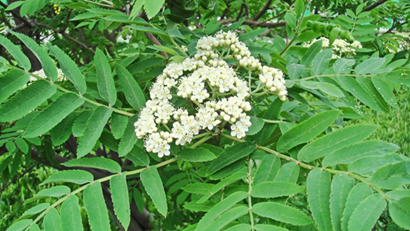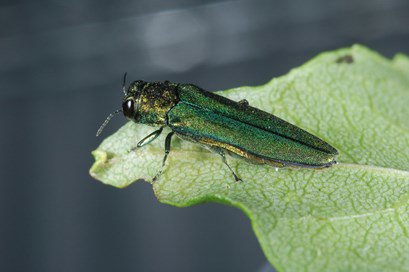A beautiful, upright, rounded form. Great fall color. Hardy and adaptable. A native tree in many parts of the U.S. The ash tree certainly has its desirable attributes, which is why many people love it.
But just like any healthy urban forest, your home landscape needs variety. To ensure your landscape trees survive specific pests and diseases, you never want too much of one type of tree.
Think you have an ash tree in your yard or looking to add one? Let’s look at how you can identify one of these trees and how you can take care of it and keep it protected from pests, particularly the Emerald Ash Borer.
How To Identify An Ash Tree
As a relative of the olive tree, there are 65 species of ash trees across the world, with 17-18 species native to the U.S.
These medium to large deciduous trees grow in parks, forests, and residential neighborhoods. Most ash tree varieties grow to heights between 50 and 80 feet with spreads of 50 feet in USDA winter hardiness zones 2 to 9.
Some species of ash trees can grow along streams or in wetlands, while other species grow in uplands and are drought tolerant.
Ash Tree Leaves

What does an ash tree look like? Ash trees have dark green leaves in spring and summer.
Almost all ash species have compound leaves which grow in groups of five, seven, or nine leaflets on an opposite branching structure, which is actually pretty unique. If you have a tree with opposite branching and compound leaves, it may very likely be ash. Ash trees produce small clusters of small white or purple flowers after the leaves emerge, and female trees bring forth light brown, winged seeds that resemble paddles and drop in late fall or early winter.
In fall, ash tree foliage can turn golden yellow or reddish-purple, depending on the species.
Ash Tree Bark

With dense hardwood, ash tree wood has made a great choice for furniture and wood flooring. Ashwood has even been used to make baseball bats, guitars, and tool handles.
The bark that covers this wood is also interesting. Older ash trees have grayish bark with pointy ridges in a woven diamond pattern.
Types Of Ash Trees
Of the ash species native to the U.S., these 5 may be found in your neighborhood.
White Ash Tree
- Hardiness Zones: You can find white ash trees in USDA hardiness zones 4 to 9.
- Where to plant: White ash trees don’t like harsh conditions. They prefer rich, moist, well-drained soil.
- Height/spread: Both a shade and ornamental tree, you can expect white ash trees to reach 50 to 80 feet in height with 40- to 50-foot spreads.
- Sunlight: Give white ash trees at least 6 hours of direct, unfiltered sun daily.
- Best time to prune: White ash trees best handle pruning during the late fall after the leaves begin falling or early spring. These cooler temperatures reduce the spread of pests and disease.
Mountain Ash Tree
- Hardiness Zones: Mountain ash trees grow well in USDA hardiness zones 2 to 5. They are not a true ash species but belong to the Rose family.
- Where to plant: The mountain ash is easy to grow in a variety of soil types, including acidic, moist, sandy, well-drained, and clay. They are adapted to cool climates. Stress from heat and drought increases their susceptibility to wood-borers and cankers.
- Height/spread: The mountain ash grows 10 to 30 feet tall with a 15-foot oval-shaped spread.
- Sunlight: This tree prefers a minimum of 4 hours of direct, unfiltered sunlight daily.
- Best time to prune: Prune this tree in late fall after leaf drop or in late winter/early spring before sap begins flowing (usually March).
Green Ash Tree
- Hardiness Zones: The green ash tree prefers USDA hardiness zones 2 to 9.
- Where to plant: Thriving in most conditions, this tree can grow in wet soils, but also shows a bit of drought tolerance. It can tolerate compact soils as well.
- Height/spread: This popular shade tree can grow 50 to 60 feet tall with a 25-foot spread.
- Sunlight: The green ash prefers full sun, which means 6-plus hours of direct, unfiltered sunlight every day.
- Best time to prune: Trim this tree during the late dormant season before new spring growth appears. Dormant season is typically late October to early March.
Black Ash Tree
- Hardiness Zones: The black ash tree grows best in USDA hardiness zones 2 to 6.
- Where to plant: Black ash is native to swamps, marshes, floodplains, and other wetlands, but it will also tolerate dryer soils.
- Height/spread: This tree can grow 40- to 60-feet tall with a 15- to 30-foot spread.
- Sunlight: The black ash tree prefers full sun, meaning no less than 6 hours of direct sunlight each day.
- Best time to prune: Prune black ash in late winter when the tree is still dormant.
Arizona Ash Tree
- Hardiness Zones: The Arizona ash tree can be found in USDA hardiness zones 7 to 11.
- Where to plant: While these trees have high drought-tolerance, they can also grow fairly well in wetter soils.
- Height/spread: This tree can grow 40- to 50-feet tall with a 30- to 40-foot spread.
- Sunlight: Arizona ash trees need full sunlight.
- Best time to prune: Arizona ash trees are ideally best to trim during late winter dormancy prior to new spring growth emerging, typically prior to early March.
Potential Threats

The ash tree’s biggest threat is the Emerald Ash Borer, an invasive beetle decimating ash trees in North America since 2002. As of 2019, the Emerald Ash Borer has killed untold millions of ash trees. Green, white, and black ash all have been killed in very high numbers. Emerald ash borer has not yet been detected in the southwest U.S, but it also killed Arizona ash when it was planted as a shade tree in China.
Adult Emerald Ash Borers are bright green in color. They lay their eggs in bark crevices. Once the eggs hatch, the larvae bore into the tree’s cambium layer and eat through its vascular system. This stops the tree’s ability to move water and nutrients.
Initially, when identifying a tree infested by Emerald Ash Borer, you may notice some canopy thinning and perhaps branch die-back. You may also notice that woodpeckers seek out Emerald Ash Borer-infested ash trees and feed on the larvae. Emerald Ash Borer infestations symptoms include D-shaped exit holes in the tree’s bark. This is a result of adult beetles leaving the tree, which typically happens in May, June, and July. Splitting bark and S-shaped galleries or tunnels under the bark can also be signs of Emerald Ash Borer infestation.
Managing Emerald Ash Borer requires repeated insecticide treatments with different options depending on the situation. Bark treatments are repeated two times per year, soil treatments are repeated every year, and stem injection treatments are repeated once every two years. . A tree that has experienced less than 30% decline can be saved, but those with canopy decline beyond that have less of a chance for recovery. Prevention and early detection are your best methods for control, as treatments are most effective if they begin before or very soon after a tree is infested. If you suspect your ash tree is threatened by an attack from Emerald Ash Borer, contact your local arborist for an ash tree inspection, as well as some prevention and treatment tips and strategies.







